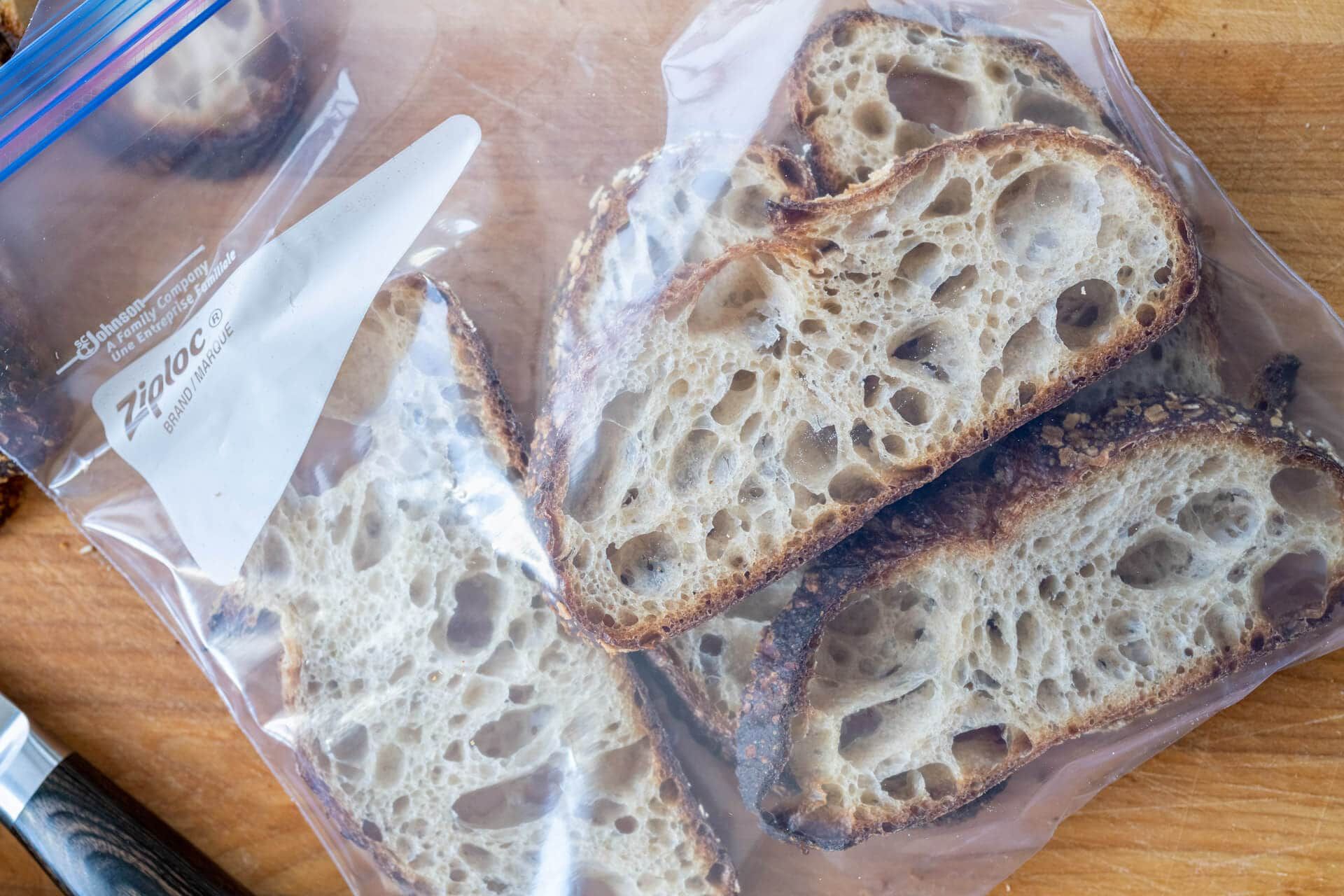

Articles
How To Store Fresh Baguette
Modified: December 7, 2023
Learn how to properly store fresh baguettes to keep them fresh and delicious for longer. Our articles provide tips and tricks to help you maintain the quality of your baguette.
(Many of the links in this article redirect to a specific reviewed product. Your purchase of these products through affiliate links helps to generate commission for Storables.com, at no extra cost. Learn more)
Introduction
Baguettes are a classic French bread loved for their crispy crust and soft interior. However, they can quickly become stale if not stored properly. The right storage techniques can help preserve the freshness of a baguette, ensuring that you can enjoy it for longer.
In this article, we will explore the importance of storing fresh baguettes correctly and the factors that can affect their shelf life. We will also provide you with the best practices for storing baguettes at room temperature, in the refrigerator, and even freezing them for long-term storage. Additionally, we will discuss how to revive a stale baguette, so you can enjoy it as if it were freshly baked.
Whether you have purchased a baguette from a local bakery or baked one at home, knowing how to store it properly will make a significant difference in its quality and taste.
Key Takeaways:
- Properly storing fresh baguettes is crucial for preserving their taste, texture, and moisture. Follow best practices like wrapping, room temperature storage, and avoiding refrigeration to enjoy delicious baguettes for longer.
- Freezing baguettes is the best option for long-term storage, allowing you to preserve their freshness for up to 3 months. Remember to double wrap, label, and thaw before reheating for optimal taste and texture.
Read more: How To Store A Baguette
Why Storing Fresh Baguette Properly is Important
Properly storing a fresh baguette is essential for several reasons:
- Preserving freshness: Baguettes have a high moisture content, which makes them susceptible to becoming stale quickly. By storing them correctly, you can extend their shelf life and maintain their texture and flavor.
- Maintaining crisp crust: One of the defining characteristics of a baguette is its crispy crust. Improper storage can cause the crust to become soggy or lose its crispness. Storing the baguette correctly helps to preserve the crust, ensuring that it stays crispy for longer.
- Preventing mold growth: Baguettes are prone to mold growth, especially in humid environments. By storing them properly, you can reduce the chances of mold formation and enjoy your baguette without any health risks.
By understanding the importance of proper storage, you can ensure that your baguette remains fresh and delicious for as long as possible.
Factors that Affect Baguette Shelf Life
Several factors can influence the shelf life of a baguette. Understanding these factors will help you determine the best storage method for your bread:
- Ambient temperature: Baguettes are best stored at room temperature. High temperatures can accelerate staling, while extremely low temperatures can adversely affect the texture.
- Humidity: Baguettes are sensitive to moisture. Excessive humidity can make the crust chewy, while low humidity can make it dry and crusty. Finding the right balance is crucial for maintaining the quality of the bread.
- Air exposure: Exposure to air causes baguettes to dry out more quickly. Proper storage methods involve minimizing air exposure to retain moisture and freshness.
- Contamination: Baguettes can easily absorb odors and flavors from their surroundings. Storing them away from strong-smelling food items can help preserve their delicious taste.
Take these factors into consideration when choosing the best storage method for your baguette to ensure optimal freshness and flavor.
Best Practices for Storing Fresh Baguette
To keep your baguette fresh for as long as possible, follow these best practices for storing:
- Wrap it properly: As soon as you bring your baguette home, tightly wrap it in a clean kitchen towel or a paper bag. Avoid using plastic bags as they can trap moisture and make the crust soft.
- Store at room temperature: For short-term storage, keep the wrapped baguette at room temperature. Find a cool and dry spot away from direct sunlight, and avoid exposing it to drafts or heat sources.
- Refrain from slicing: While it may be tempting to slice the entire baguette at once, it is best to resist the temptation. Sliced baguettes dry out faster than whole ones. Slice only what you need right before serving.
- Avoid refrigeration: Refrigerating baguettes can actually accelerate staling. The cold temperatures can dry out the bread and make it lose its delightful texture. Only resort to refrigeration if you need to extend the shelf life of a partially consumed baguette for an additional day.
- Freezing for long-term storage: If you need to store a baguette for an extended period, freezing is the best option. Double wrap the bread in plastic or aluminum foil, then place it in a freezer-safe bag. When thawing, allow the baguette to come to room temperature before reheating.
By following these best practices, you can ensure that your baguette stays fresh and delicious for as long as possible.
Option 1: Storing Baguette at Room Temperature
Storing a baguette at room temperature is the ideal method for short-term storage. Here’s how to do it:
- Wrap it properly: Start by tightly wrapping the baguette in a clean kitchen towel or a paper bag. This helps to retain the bread’s moisture and prevent it from drying out.
- Choose the right storage spot: Find a cool and dry spot in your kitchen or pantry to store the baguette. Avoid areas with direct sunlight, drafts, or heat sources, as these can compromise the bread’s quality.
- Minimize air exposure: To further preserve freshness, place the wrapped baguette in a bread box or a bread bag. These storage containers help to reduce air exposure and maintain the bread’s moisture.
- Consume it within 2-3 days: A baguette stored at room temperature can remain fresh for about 2-3 days. After this period, it may start to become stale. Enjoy the baguette within this timeframe for the best taste and texture.
Remember to only slice the baguette right before serving to keep it as fresh as possible. By following these steps, you can enjoy a delicious and crusty baguette at room temperature.
Store fresh baguette at room temperature for up to 2 days in a paper bag to maintain its crust. To extend its shelf life, freeze it in a resealable plastic bag for up to 3 months.
Read more: How To Store French Baguette
Option 2: Storing Baguette in the Refrigerator
While storing a baguette at room temperature is the preferred method, sometimes you may need to store it in the refrigerator to prolong its shelf life. Follow these steps to store a baguette in the refrigerator:
- Wrap it properly: Take the baguette and wrap it tightly in plastic wrap or place it in a resealable plastic bag. Make sure to remove as much air as possible to prevent the bread from drying out.
- Refrigerate promptly: Place the wrapped baguette in the refrigerator as soon as possible after purchasing or baking. This helps preserve its freshness and texture.
- Use within 1-2 days: Unlike storing at room temperature, baguettes stored in the refrigerator will not remain fresh for as long. Consume the bread within 1-2 days to enjoy it at its best quality.
- Reheat before serving: When you’re ready to enjoy the baguette, remove it from the refrigerator and let it come to room temperature. To bring back its crustiness, preheat the oven to 325°F (163°C) and warm the bread for about 5-10 minutes.
It’s important to note that refrigeration can cause the baguette to lose some of its crustiness and become slightly denser. Therefore, it’s best to only resort to this method when you need to extend the shelf life of the bread for a day or two.
Option 3: Freezing Baguette for Long-Term Storage
If you want to store a baguette for an extended period, freezing it is the best option. Here’s how to freeze a baguette properly for long-term storage:
- Double wrap the baguette: Start by tightly wrapping the baguette in plastic wrap or aluminum foil. This creates a protective barrier to prevent freezer burn and maintain the bread’s moisture.
- Place it in a freezer-safe bag: Once the baguette is wrapped, put it inside a freezer-safe bag or airtight container. This provides an extra layer of protection against freezer odors and helps maintain the bread’s quality.
- Label and date the package: Before placing the baguette in the freezer, label the package with the date of freezing. This will help you keep track of how long the bread has been stored and ensure you consume it within a reasonable timeframe.
- Freeze for up to 3 months: Baguettes can be frozen for up to 3 months without significantly affecting their quality. However, it is best to consume them within the first month for the best taste and texture.
- Thaw and reheat before serving: When you’re ready to enjoy the baguette, remove it from the freezer and let it thaw at room temperature. To revive its crustiness, preheat the oven to 325°F (163°C) and warm the bread for about 5-10 minutes.
By following these steps, you can freeze a baguette and preserve its freshness for an extended period. This method is especially useful when you have leftover bread or want to stock up on baguettes for future use.
How to Revive Stale Baguette
Even with the best storage methods, baguettes can sometimes become stale. Fortunately, there are ways to revive a stale baguette and bring it back to life. Here’s how:
- Mist with water: Lightly mist the stale baguette with water to add moisture back into the bread. Use a spray bottle or wet your hands and flick water onto the surface of the bread.
- Oven method: Preheat your oven to 325°F (163°C). Once heated, dampen a kitchen towel and wrap it around the baguette. Place the wrapped baguette in the oven for about 10 minutes. The steam created by the damp towel will help rejuvenate the bread and make it softer.
- Slice and toast: If the baguette is too stale to be revived with water or heat, consider slicing it into thin pieces. Toast the slices in a toaster or under the broiler until they become crisp and golden. This transforms the stale bread into crunchy crostini, ideal for dips or as a base for bruschetta.
- Make breadcrumbs: If the baguette is beyond revival, don’t despair. Transform it into breadcrumbs by slicing it into small pieces and processing them in a food processor or blender. Store the breadcrumbs in an airtight container and use them for recipes that call for breadcrumbs, such as breading chicken or topping casseroles.
Remember, while these methods can help revive a stale baguette, it is always best to consume the bread as fresh as possible for the optimal taste and texture.
Conclusion
Properly storing fresh baguettes is essential to preserve their taste, texture, and freshness. By following the best practices outlined in this article, you can ensure that your baguettes stay delicious for longer periods of time.
Storing a baguette at room temperature is the preferred method for short-term storage. Make sure to wrap the bread properly, choose an appropriate storage spot, and minimize air exposure to maintain its crustiness and moisture.
Refrigeration should only be used when you need to extend the shelf life of a baguette for an additional day or two. Remember to wrap the bread tightly, consume it within a short period, and reheat it before serving.
For long-term storage, freezing is the best option. Double wrap the baguette, place it in a freezer-safe bag, label it, and freeze it for up to 3 months. Thaw and reheat the bread when you’re ready to enjoy it.
If you have a stale baguette, there are methods to revive it. Mist it with water and warm it in the oven, or slice it and toast the pieces to create delicious crostini. Alternatively, you can transform the stale baguette into breadcrumbs for future use.
Remember, regardless of the storage method and bread condition, always consume baguettes as fresh as possible for the best taste and experience.
Now armed with these storage techniques, you can confidently enjoy fresh and flavorful baguettes for days to come.
Frequently Asked Questions about How To Store Fresh Baguette
Was this page helpful?
At Storables.com, we guarantee accurate and reliable information. Our content, validated by Expert Board Contributors, is crafted following stringent Editorial Policies. We're committed to providing you with well-researched, expert-backed insights for all your informational needs.















0 thoughts on “How To Store Fresh Baguette”